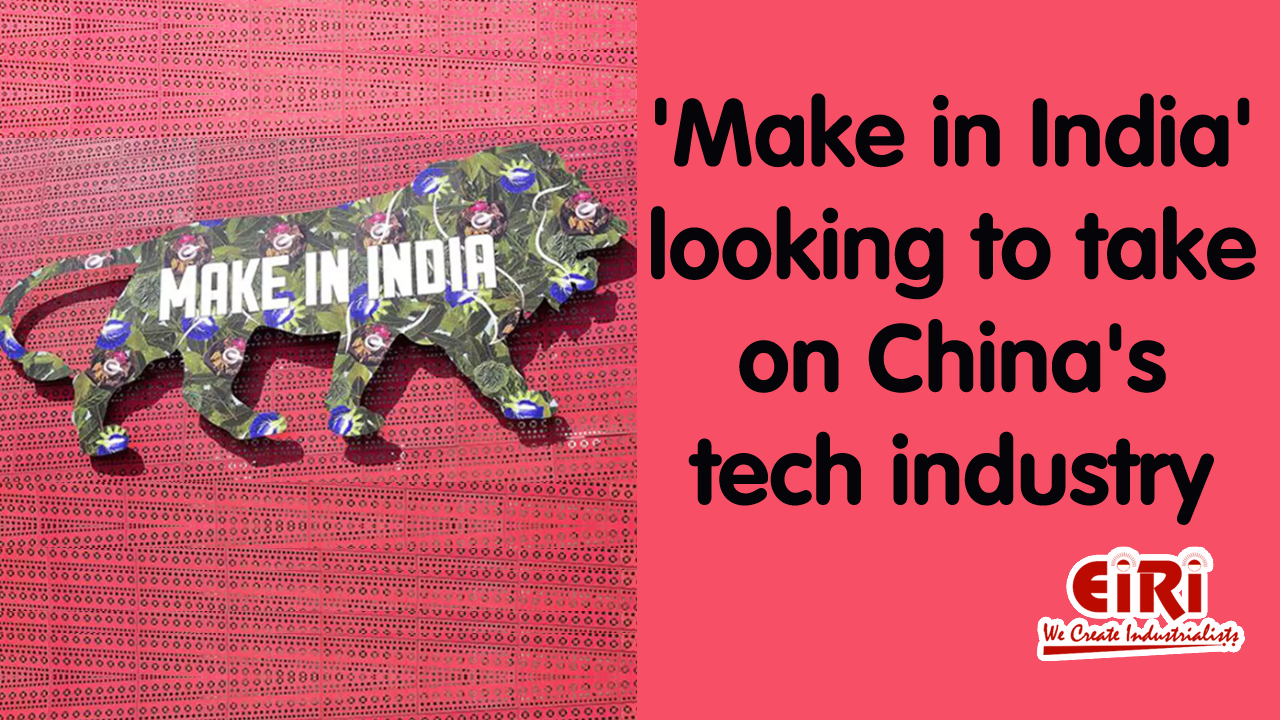‘Make in India’ looking to take on China’s tech industry
China is the leading manufacturing hub in the world that produces a wide range of products in large numbers. However, the recent Covid-19 epidemic forced may companies to leave China due to high losses and other problems. As a result, they are searching some alternatives to relocate their operations in order to plan everything accordingly. India is becoming the most preferred choice of many multinational companies due to better infrastructure facilities and other factors. In fact, it provides the best opportunities for investors to focus more on their objectives effectively.
Prime Minister Narendra Modi launched the Make in India initiative on September 25, 2014, with the primary goal of making India a global manufacturing hub, by encouraging both multinational as well as domestic companies to manufacture their products within the country.
What is Make in India project?
Make in India is a major programme initiated by Government of India in order to facilitate investments as soon as possible. It aims at attracting investors from different parts of the world to start their business accordingly. Another thing is that it provides ways to stabilize the economy with high success rates. India will overtake other countries in coming years when it comes to investments. Leading brands also like to setup their plants in India to fulfil the expectations of suppliers. Apart from that, they even focus more on enhancing their productivity in order to meet the demands.
The initiative is built on four pillars which are as follows:
New Processes: The government is introducing several reforms to create possibilities for getting Foreign Direct Investment (FDI) and foster business partnerships. Some initiatives have already been undertaken to alleviate the business environment from outdated policies and regulations. This reform is also aligned with parameters of World Bank’s ‘Ease of Doing Business’ index to improve India’s ranking on it.
New Infrastructure: Infrastructure is integral to the growth of any industry. The government intends to develop industrial corridors and build smart cities with state-of-the-art technology and high-speed communication. Innovation and research activities are supported by a fast-paced registration system and improved infrastructure for Intellectual Property Rights (IPR) registrations. Along with the development of infrastructure, the training for the skilled workforce for the sectors is also being addressed.
New Sectors: ‘Make in India’ has identified 25 sectors to promote with the detailed information being shared through an interactive web-portal.1 The Government has allowed 100% FDI in Railway and removed restrictions in Construction. It has also recently increased the cap of FDI to 100% in Defense and Pharmaceutical.
New Mindset: Government in India has always been seen as a regulator and not a facilitator. This initiative intends to change this by bringing a paradigm shift in the way Government interacts with various industries. It will focus on acting as a partner in the economic development of the country alongside the corporate sector.
Factors that make India an attractive investment hub
There are some factors which make India an attractive investment hub. They include cheap labour costs, technical advancements, low tax rates, and skilled employees. In addition, the policies introduced by Indian government made the country a favourite destination for investments. Furthermore, India is a great market for a wide range of products and that’s why many companies prefer the destination to fulfil the expectations of suppliers. Besides that, they want to implement modern technologies in production process. In addition, Indian markets have wide network connectivity that allows industries to reach customers as soon as possible.
Initiatives taken by Indian government
Indian government is preparing a list of categories that contain the names of companies who want to relocate their base. It even appointed a special team to know their requirements and other things when they like to invest in Indian markets. The investments are likely to grow in the future that will boost the economy significantly. Also, they provide jobs for several people with better salaries. A recent survey says that India will lead other countries in foreign direct investments (FDI) that may impact the economy. It even states that India will become a powerful economy after a few years.
- For the first time, the sectors of railways, insurance, defense, and medical devices have been opened up for more Foreign Direct Investment (FDI).
- The maximum limit in FDI in the defense sector under the automatic route has been raised from 49% to 74%. This increase in FDI was announced by Finance Minister Nirmala Sitaraman on May 16, 2020.
- In construction and specified rail infrastructure projects, 100% FDI under the automatic route has been permitted.
- There is an Investor Facilitation Cell that assists investors from the time of their arrival in India to their departure from the country. This was created in 2014 for giving services to investors in all phases such as the pre-investment phase, execution, and also after delivery services.
- The government has taken steps to improve India’s ‘Ease of Doing Business’ rank. India climbed 23 points in the Ease of Doing Business index to 77th place in 2019, becoming the highest-ranked in South Asia in this index.
- The Shram Suvidha Portal, eBiz portal, etc. have been launched. The eBiz portal offers single-window access to eleven government services connected with starting a business in India.
- Other permits and licenses required to start a business have also been relaxed. Reforms are being undertaken in areas like property registration, payment of taxes, getting power connection, enforcing contracts, and resolving insolvency.
- Other reforms include licensing process, time-bound clearances for applications of foreign investors, automation of processes for registration with the Employees State Insurance Corporation and the Employees Provident Fund Organization, adoption of best practices by states in granting clearances, decreasing the number of documents for exports, and ensuring compliance through peer evaluation, self-certification, etc.
- The government hopes to improve physical infrastructure chiefly through the PPP mode of investment. Ports and airports have seen increased investment. Dedicated freight corridors are also being developed.
The government has launched plans to create 5 industrial corridors. They are underway. These corridors are spread across the length and breadth of India, with a strategic focus on inclusive development which will augment industrialization and urbanization in a planned manner. The corridors are:
- Delhi-Mumbai Industrial Corridor (DMIC)
- Amritsar-Kolkata Industrial Corridor (AKIC)
- Bengaluru-Mumbai Economic Corridor (BMEC)
- Chennai-Bengaluru Industrial Corridor (CBIC)
- Vizag-Chennai Industrial Corridor (VCIC)
Make in India VS Made in India
- Make in India focuses more on attracting the foreign investors to make investments towards the factors of production required in the Indian manufacturing sector. Whereas, Made in India primarily aims at domestic factors of production (including investments) in the manufacturing of products.
- Make in India is not a brand but a strategy of the Indian government to deal with the issue of sluggishness in the Indian manufacturing industry. Made in India refers to branding of products manufactured in India and building their identity in the Indian as well as foreign markets.
- The profits generated under Make in India initiative will also consist of the share of foreign investors while the profits earned from Made in India initiatives is retained within the Indian economy.
Both the policies seem to benefit the Indian economy in their respective ways. On one hand, Make in India will boost foreign investments in the economy and on the other, Made in India will help the country being self-reliant in terms of manufacturing of products. Therefore, a logical route is needed to be adopted.
India’s major concern is the lack of financial resources available with the domestic manufacturers due to which the quality of the products gets compromised. If they would be supplied with sufficient financial resources, the quality and standards of the domestic products will get improved. For this, Make in India propaganda can come into play. The campaign can be utilized to generate good amounts of means in the form of FDIs for the domestic manufacturers so that they can manufacture good quality products domestically. This will also help them and their products to gain self-reliability and global recognition. Once they have achieved a stage of stability, they can gradually shift to manufacturing their products under Made in India campaign.




